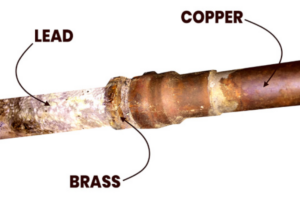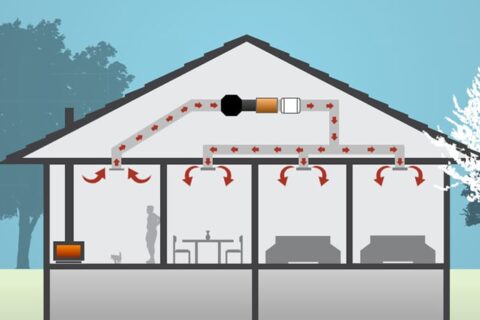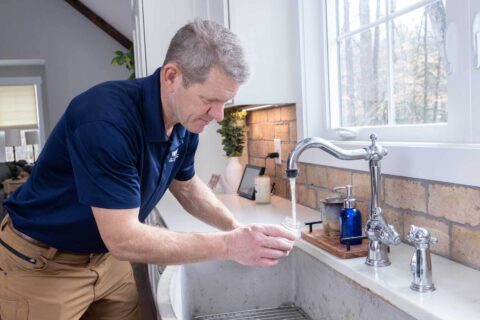When to Repair or Replace Your Aging Plumbing Pipes
Key Takeaways
-
Repair If your aging plumbing pipes are leaking, corroding, low water pressure, or banging noises are present, replacement may be necessary. Routine inspections could identify these problems before they worsen.
-
Repair may be possible for small leaks, local damage, limited corrosion, or pipes with easy access. Repairing them quickly will help ensure your plumbing’s long-term health.
-
Replacement would be the preferred option for pipes with general deterioration, failing materials, or severe corrosion. Providing a better quality of life upgrading means better water quality, pressure and system reliability.
-
Pipe material is another huge factor as to whether pipes qualify for repair or replacement. Copper provides longevity at 70-80 years, but PVC and PEX come with today’s technology providing durable, flexible piping for long-term performance.
-
Consider the short- and long-term costs of repair vs. replacement. Consider what you may spend down the line and advantages of using newer materials to determine what’s best for your home.
-
Routine preventive maintenance, including regular inspections, cleaning, and corrosion prevention, can more than double the life of your plumbing system.
Aging plumbing pipes can cause a range of problems, from annoying leaks to extensive water damage. There are some factors you need to take into account when determining if you should repair or replace the pipes.
These factors are the material, age, and scope of damage. Copper pipes, for example, can last an average of 50 years, but galvanized steel pipes often require repairs after just 20 years. Localized damage may be appropriate for repairs, but when there’s corrosion throughout, it’s time to consider replacement.
Costs, water quality, and potential disruptions are equally critical to consider. Knowing all of these things will help you make the best financial decisions that save you money and avoid headaches down the line.
Taking action before the situation becomes serious will keep your plumbing functioning smoothly and save you from more expensive emergencies in the future.
Understanding Aging Plumbing Pipes
Common signs of aging pipes
Older pipes typically present noticeable symptoms of aging infrastructure. Corrosion or rust on exposed pipes is a clear sign that the pipe’s material is deteriorating. This corrosion can pose risks to both drinking water quality and pipe structural integrity.
Discolored water, like a yellow or brown color, can indicate rust and debris accumulation within the pipes. This may even result in noxious odors produced by bacteria or mold development, which flourish in failing systems.
Frequent leaks around your pipes or large puddles of water around your fixtures are an alarming sign too. Even small drips can indicate bigger underlying problems, with 20-50% of homes experiencing hidden leaks.
Low water pressure or sluggish drainage in sinks and showers is typically caused by a buildup of sediment or corrosion. These problems can reduce the pipe’s inside diameter.
Causes of plumbing pipe deterioration
There are a number of other factors that impact pipe longevity. Environmental factors, like soil pH levels or ground shifts, can compromise the integrity of underground piping.
Tree roots are a third frequent offender, able to crack or infiltrate pipes. Water chemistry makes a huge difference. Hard water can accelerate corrosion, particularly in older materials such as galvanized steel, which has an average service life of only 20 to 50 years.
Temperature fluctuations can create extreme expansion and contraction, straining the pipes and eventually resulting in cracks or breaks.
How pipe material affects longevity
As you might expect, pipe material has a direct influence on durability. Copper pipes, for example, can last more than half a century and hold up to corrosion better than their galvanized-steel counterparts.
PVC pipes under perfect conditions can last forever, but PEX pipes are rated at 40-50 years. Older materials such as lead or polybutylene represent serious dangers.
Lead pipes, found in pre-1940s homes, can leach dangerous metals into water, while polybutylene, used through the mid-1990s, is prone to sudden breakage.
Additionally, regular maintenance can go a long way in prolonging any material’s lifespan and avoiding expensive damage.
When to Repair Aging Plumbing Pipes
1. Address Minor Leaks or Cracks
Any small leaks or cracks can usually be repaired without having to remove all of the plumbing. Fast action is important to minimize further water damage or potential repair costs. Sealants and patches work well for addressing leaks immediately, particularly for hairline cracks/pinhole leaks.
After a repair, it’s critical to monitor these spots. Monitor for evidence of new leaks or repeated damage. Keeping a record of every repair helps you keep track of the age and condition of your plumbing system. This track record will further help you make smart future decisions.
2. Resolve Isolated Pipe Damage
When damage is isolated to a certain area, it’s less expensive to restore just that area. In this case, replacing the entire system isn’t warranted. If one pipe bursts due to freezing temperatures, you can handle the situation right away.
Repairing only that individual pipe is significantly more economical than replacing the whole system. Targeted repairs should be completed judiciously so as not to create new issues down the line, such as uneven pressure. Routine inspections allow for targeted repairs and replacements where needed, fixing isolated issues before they lead to unexpected, widespread failures.
3. Repair Pipes with Minimal Corrosion
Pipes with signs of light corrosion can usually be repaired. With regular cleaning of the impacted areas and application of protective coatings, the life expectancy can be increased by decades. Just a bit of corrosion on a copper pipe can still deliver several years of consistent service if addressed in time.
Regular maintenance prevents corrosion, which in turn prevents worse, more costly problems that may need replacement.
4. Fix Pipes in Accessible Areas
Repairing pipes is often more feasible and cost-effective when access is not an issue. Pipes that run in basements, crawl spaces, or behind basic drywall are easier, less disruptive, and more economical to replace. This accessibility lowers labor costs and lessens the disruption of people’s lives and routines.
Repairing in these locations is a chance to identify and repair other problems, keeping the entire system running efficiently. Maintaining a record of easy fixes can offer valuable touchstones for future plumbing projects.

5. Consider Repairs for Budget Constraints
Repairing pipes can be a short-term solution if replacing them isn’t economically realistic. Striking a balance between upfront repair costs and future replacement costs is key. Repairing a small leak is pretty straightforward.
Taking the time to plan an incremental repiping project lets you spread the costs and avoid blowing your budget. Creative financing options or allowing for upgrades in phases can make these projects more manageable long-term.
When to Replace Aging Plumbing Pipes
1. Replace pipes with widespread damage
When damage has spread across many sections of your plumbing, it’s usually more cost-effective to replace the whole system. Temporary fixes often result in greater harm later on. For instance, leaks in a high number of locations or many pipes bursting at once can be a sign that a system-wide network is deteriorating.
Repair may seem like the more cost-effective solution upfront. They often don’t address the underlying problem, especially in homes with galvanized steel pipes that are nearly a half-century old. Upgrading failing systems prevents premature failure while protecting against the uncertainties of future emergencies.
Professional plumbers immediately evaluate the scope of the damage. They advise you based on whether or not your entire pipeline needs to be replaced, saving you time and money through your project’s lifecycle.
2. Upgrade outdated pipe materials
Materials older homes built before the 1980s commonly used include lead or galvanized steel. With the benefit of hindsight, we now know these were dangerous materials to use. Lead pipes, especially, are unacceptable and must be replaced without delay.
With newer materials such as PEX and copper, these pipes are built to last, allowing for increased water flow and less risk of corrosion. Copper, for example, can last more than half a century, which means it can be a wise long-term investment.
Many local building codes will require certain materials to be used, so checking these regulations will help you adhere to them while boosting your home’s plumbing efficiency.
3. Address frequent plumbing issues
Recurring leaks, clogs, and other issues are surefire signs that your pipes are past their prime. Eventually, aging pipes can corrode or rust, creating blockages or endless leaks. If you’re making frequent plumbing repairs, it’s time to examine your plumbing infrastructure.
The issue may actually lie below the surface. When replacing aging pipes, use durable replacement pipes to avoid future disruptions. This preventive upgrade not only protects your home’s plumbing system but saves your home from unwanted emergencies and costly repairs.
4. Replace pipes with advanced corrosion
Corrosion eats through pipes, leaving them at risk for a leak or burst. Rusted pipes not only compromise your water quality, but can cause serious structural damage over time if not taken care of immediately. Steel galvanized steel was the most common metal used in older homes, but it rusts easily.
Replace it before it’s at the end of its lifespan. It’s important to use proper tools to measure corrosion levels accurately, allowing you to understand when replacement is necessary. With an early approach to corrosion, you prevent expensive replacements and safeguard your home from potential water damage or contamination.
5. Improve water quality and pressure
Low water pressure or discolored water are both signs that you may have aging pipes. For instance, mineral deposits or rust can diminish water pressure, making appliances less efficient and making everyday activities like washing dishes more difficult.
When you replace aging pipes, you bring back reliable water pressure and higher quality water. Newer materials such as PEX and copper offer improved water safety. They ward off accumulation, guaranteeing you have clean and consistent water.
Once replacement occurs, monitoring changes in water quality can both verify the new system’s success and guarantee the investment pays off over time.
Lifespan of Plumbing Pipe Materials
Lifespan of Copper Pipes
Copper piping is very durable and can last anywhere from 50 to 70 years. Provided they are well-installed and maintained, many last well beyond 70 years! This durability translates to low-maintenance costs, making them a smart investment for the future of your plumbing.
Copper has a natural resistance to bacteria and works well in delivering both cold and hot water, further boosting its convenience and safety. Wear and corrosion can accumulate over time and are more pronounced in regions with acidic water supplies.
With routine inspections, you can catch any problems before they become larger, prolonging their lifespan. Though copper might be more expensive at first, its durability and all-around advantages usually justify the investment for homeowners.
Lifespan of Galvanized Steel Pipes
Galvanized steel pipes often last between 20 and 50 years. While commonly found in older homes, these pipes come with a major catch. They are easily prone to rust and corrosion, which reduces the flow of water and can compromise the quality of drinking water.
Approaching the end of their lifespan, the chances of pipes leaking or bursting increases drastically, making replacement an important factor to consider. For homes with old galvanized systems, replacing with new materials will provide better performance and peace of mind.
Lifespan of PVC and PEX Pipes
PVC has an expected lifespan of 25 to 40 years. PEX pipes frequently last beyond this lifespan due to their flexibility and ability to resist cracking. PEX materials are immensely popular in today’s plumbing for making installations easier and cutting back on leaks.
Both materials are very lightweight and cost-effective, making them perfect fits for a renovation or new build. They’re a big help in overall water efficiency, saving residents money on utility bills in the long term.
Lifespan of Cast Iron Pipes
Cast iron pipes, which are commonly found in older homes, have a lifespan of 50 to 100 years. They are vulnerable to rust and corrosion and should be avoided in humid or damp locations. Over time, this can cause clogs or deterioration, leaks, and flooding.
Homeowners with cast iron systems should consider retrofitting to newer materials. Alternatives such as PVC or PEX offer better durability and functionality to meet the demands of modern plumbing.
Factors to Consider Before Replacing Pipes
Evaluate the age of the plumbing system
The age of your plumbing is a significant factor in determining whether to replace or repair your plumbing. Galvanized steel pipes are common in homes constructed between the 1930s and 1980s. They usually start to corrode within 20 to 50 years.
Copper pipes can last 50 years or longer. If your home was built before the 1980s, find out whether you still have lead pipes in your home. Replace them as soon as possible to shield your health from avoidable dangers.
That means homes built in 1920 frequently have replacement costs more in line with homes from 1980. Consider long-term replacements to prevent unexpected, overwhelming costs.
Assess the extent of damage
Whether you have enough strain on your pipes to warrant replacement, a detailed inspection is necessary to determine their condition. Low water pressure might indicate corrosion or clogging, prevalent in homes with aging infrastructure.
If the damage is more limited in scope, a localized, targeted repair may be sufficient. Signs like rust or hidden leaks could mean a complete replacement is needed. Taking down notes and photos during inspections can help ensure decisions are made with the best possible information.
Analyze repair versus replacement costs
Depending on the current situation, replacing old pipes can cost $1,500 or jump to more than $15,000. Weigh this against costs of repair, including possible greater costs down the road if repairs are short term.
Warranty coverage new plumbing typically includes warranties, which provide added protection and assurance.
Consider future maintenance needs
Newer materials such as PVC or PEX need much less maintenance than traditional materials such as galvanized steel. Consider investing in low-maintenance materials that will prevent future costly repairs and save you time on routine maintenance.
Routine inspections help keep the system running at peak performance.
The Repiping Process Explained
Steps involved in repiping a home
Repiping starts with a detailed inspection by a plumber to determine the condition of your existing pipes. For homes over 50 years old, this step often reveals issues like corrosion, leaks, or outdated materials like galvanized steel or lead.
Once the assessment is complete, the next step is selecting materials. Copper is a popular choice due to its durability and 50+ year lifespan, though options like PEX may be considered for cost-efficiency.
Ensure that work areas including under sinks or behind walls are cleared to help plumbers work safely and efficiently. This might require you to move some furniture or appliances temporarily.
This process includes taking out the old piping and replacing it with new piping all over your home. Professionals are well versed in working in sections, helping to maintain efficiency and limit downtime.
How to choose the right pipe material
Deciding which repiping material is best for you will depend on your budget, local building codes, and your unique situation. Copper is great for its strength and reliability, while PEX provides flexibility and cost savings.
In Southern California communities such as Hemet or Moreno Valley, having discussions with decision makers and experts is key. They’ll make sure you meet regulatory requirements while guiding you to the best repiping option for your home.
Tips to minimize disruption during repiping
You can minimize the inconvenience by talking about the process and scheduling with your plumbing repiping team. Safe interim water options, such as water storage tanks, can be provided.
Provide clear pathways, and let members of the household know what to expect, and when, in advance. Maintaining open lines of communication with your plumber will help make the repiping process go more smoothly.
Preventive Maintenance for Plumbing Pipes
Regular inspections for early detection
Annual plumbing inspections are key to spotting issues early before they become major repairs. An expert plumber can comprehensively test your system, checking for evidence of leaks, corrosion, rusts or fragile joints.
Advanced plumbing technology, such as camera line inspections, provide an unprecedented view within your pipes. They are highly effective at detecting hidden issues, such as blockages and cracks. Tree root intrusion in underground pipes can be discovered through a camera inspection.
Without this important check, the defect can remain undetected until it breaks and creates significant damage. Further, documenting these findings will help you keep a pulse on the general condition of your plumbing. This allows them to be proactive and plan for any future repair or replacement.
Repair small issues, like a pinhole leak, immediately. This preventive maintenance step will save you from a lot of water damage and costly repairs in the future.
How to prevent pipe corrosion
Corrosion is one of the more prevalent causes of aging pipes. Protective coatings like epoxy lining can be safely applied to metals pipes to extend their service life.
Keeping an eye on the water’s chemistry is the other major step—excess acidity or mineral content can speed up corrosion. For instance, homes with hard water will likely require installation of a water softener to neutralize the excess minerals.
Insulating pipes can prevent temperature-related stress, which is especially important in colder climates. Preventive maintenance stops corrosion from building up and eroding your pipes.
This preventive maintenance work will help keep your plumbing system running in top form for many years to come.
Tips to reduce wear and tear on pipes
How you treat your pipes on a daily basis can make all the difference in how long they last. Don’t flush things like wipes or sanitary products, since these items can cause clogs and extra stress on your plumbing system.
Drain screens are a simple, yet effective way to trap food particles and hair before they go down the drain. This minor change goes a long way in preventing costly clogs.
Water pressure is another factor to keep an eye on—too much pressure will cause pipe joints to lose strength and integrity over time. For example, a pressure regulator can help maintain appropriate levels and avoid causing undue stress.
With a little routine maintenance, you can keep your plumbing in great shape. Simple tasks such as clearing slow drains and monitoring for leaks reduce unnecessary wear and tear.
Conclusion
The choice between repairing or replacing aging plumbing pipes depends on their condition, material, and the overall plumbing situation. Repair is the most effective solution for small leaks and systems that are relatively new. When you have old, worn-out pipes or extensive damage, replacement wins out. Understanding expected lifespans of your materials and being proactive with routine maintenance will save you time, money, and stress in the long run.
Repairing or replacing your aging plumbing brings peace of mind. When in doubt, repair vs. Replace decision making requires the advice of a qualified plumber you can trust. Some small considerations now will help ensure your water continues to flow freely and safely for decades to come.
Have a plumbing problem and not sure what to do? Contact the experienced pros at [Company] for honest insights and assurance. Your home deserves more than a quick fix.
Frequently Asked Questions
What are the signs of aging plumbing pipes?
Discolored waterLow water pressureFrequent leaksOdd noisesVisible corrosion
Here are a few signs that your pipes are in need of repair or replacement.
How long do plumbing pipes typically last?
So how long do pipes last, exactly? The typical lifespans of plumbing systems vary by material: Copper can last over 50 years, PVC can last anywhere from 50 to 70 years, and galvanized steel pipes last about 20-50 years. Regular plumbing maintenance can significantly prolong their life.
When should I repair instead of replacing pipes?
Repair is best for small leaks, localized damage, or clogs in residential plumbing. If the pipes are mostly in good shape, a plumbing inspection can help save money and time.
When is it time to replace plumbing pipes?
Replace outdated pipes that are heavily corroded, prone to regular leaking, or past their typical lifespans. Professional pipe replacement provides long-term safety and efficiency for your home’s plumbing system.
What factors should I consider before replacing pipes?
When considering pipe replacement, pay attention to the age and material of your old plumbing pipes, as well as the extent of any visible corrosion and water quality issues. An experienced plumber can help you determine the best option.
What does the repiping process involve?
During repiping, your plumbing expert will remove old plumbing pipes or damaged pipes and install new ones. This process includes pipe inspection, removal, installation, and testing, ensuring a reliable plumbing system with minimal disruption.
How can I prevent plumbing pipe issues?
Preventive care is truly essential for maintaining a reliable plumbing system. Regular plumbing inspections with a reputable plumber can help catch symptoms like leaks or low pressure before they escalate into expensive repairs.


